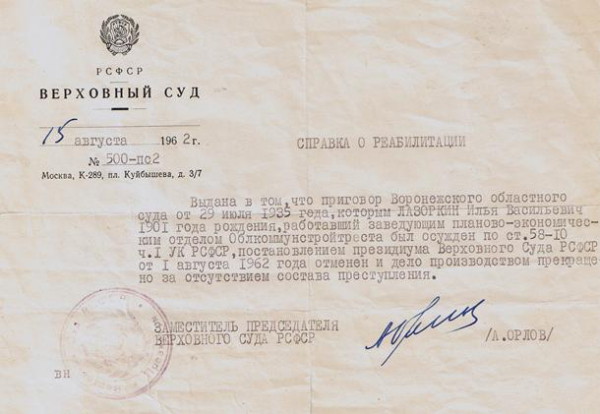Rehabilitation
Rehabilitation. A Soviet legal practice by which a previously condemned person was cleared, often posthumously, of the crimes attributed to him or her and was restored officially to full civilian status. The procedure was one of the key methods by which the Soviet regime tried to reclaim public confidence and legitimacy after having destroyed, through execution, imprisonment, deportation, and exile, millions of innocent people. The wide-scale use of extralegal procedures and the gross violations of judicial processes that took place under Joseph Stalin's regime eventually had to be admitted and condemned by the Communist Party, and the stigma of guilt, which justified continued discrimination against the victims of repression and their families, had to be removed.
In Soviet Ukraine rehabilitation began soon after Stalin's death. Several family members of repressed Ukrainian leaders, such as Stanislav Kosior, were released from the labor camps. The first group of Stalin's victims who profited from the milder climate in 1953 was the Soviet partisan group. Its members were repressed in 1944 for acting without proper clearance from the Soviet partisan staff in Ukraine (see Soviet partisans in Ukraine, 1941–5). Until 1956 the process of rehabilitation was conducted in silence, with no announcements in the press. At the 20th Party Congress (1956) A. Mikoyan and Nikita Khrushchev praised some Party leaders in Ukraine who had been repressed by Stalin, but there was little interest in rehabilitating them. Only in 1958–9 was N. Khrushchev's secret speech echoed in the press by a few references to prominent Ukrainian victims of Stalinist terror.
The 22nd Congress of the Communist Party of the Soviet Union (1961) persuaded the Ukrainian leaders to adopt a bolder policy on rehabilitation. During the congress Mykola Pidhirny exposed Lazar Kaganovich's role in the purge of 1947, and three months later he drew public attention to Mykola Skrypnyk. It was not until 1962 that Skrypnyk was cleared of ‘bourgeois nationalism,’ and he was so cleared in the context of an attack on Joseph Stalin's nationality policy. The use of rehabilitation for political purposes was typical of the late Khrushchev period. The Ukrainian press participated in the anti-Stalin campaign of 1963–4. The publication of information about Volodymyr Zatonsky was an important step. But the disclosures continued to be unreliable and incomplete. Although many victims were mentioned, their ultimate fate remained a secret. Ukrainian victims received less attention than victims from other national groups. After 1963 a number of Ukrainian leaders of the 1930s, such as E. Veger, M. Maiorov, Kyrylo Sukhomlyn, Panas Liubchenko, and A. Medvedev, were rehabilitated. In the 1970s the anti-Stalin campaign was curtailed, yet the names of prominent victims continued to appear, M. Chuvirin and V. Stroganov, for example. The second edition of Ukraïns'ka radians'ka entsyklopediia (Ukrainian Soviet Encyclopedia, 1977–85) contained information about many rehabilitated leaders without explaining how they perished.
The rehabilitation of victims who were not Party members was a more delicate problem. In the 1950s most labor-camp inmates who had been involved in the postwar national movements were not released, let alone rehabilitated. The new category of victims, the prisoners of conscience of Nikita Khrushchev's and Leonid Brezhnev's regimes, had not been rehabilitated by 1991. Under Mikhail Gorbachev's policy of glasnost the amount of information about Stalinist and later repressions increased dramatically, but the range of rehabilitation categories grew slowly.
BIBLIOGRAPHY
Goudoever, A. van. The Limits of Destalinization: Political Rehabilitation in the Soviet Union (London–New York 1986)
Albert Peter van Goudoever
[This article originally appeared in the Encyclopedia of Ukraine, vol. 4 (1993).]
